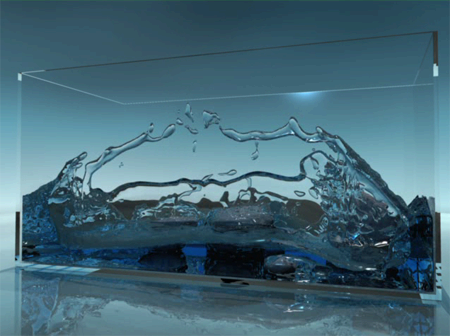 When Enable Liquid Simulation is on, you can use the Liquids attributes to create fluid simulations that look and behave like realistic liquids. Liquid simulations require a combination
of Liquids attribute and other fluid attribute settings to create effects that have the physical characteristics of liquids.
When Enable Liquid Simulation is on, you can use the Liquids attributes to create fluid simulations that look and behave like realistic liquids. Liquid simulations require a combination
of Liquids attribute and other fluid attribute settings to create effects that have the physical characteristics of liquids.

The following sections provide attribute settings that are commonly used to create liquid simulations. The recommended settings are intended only as a starting point for your effect.
You can also import a fluid Liquids example file, which are included with Maya, or apply a liquid attribute preset as starting points to your liquid effect. See Getting started with Fluid Effects and Use fluid attribute presets.
Set the following fluidShape node attributes.
| Attribute section | Attribute: value | Notes |
|---|---|---|
| Container Properties | Base Resolution/ Resolution: 80 or greater | A high Resolution value is required to obtain sufficient detail and realistic behavior in the liquid. See Resolution and Base Resolution. |
| Dynamic Simulation | Viscosity: 0.02 | Small amounts of Viscosity can help the fluid fully settle to a flat surface. See Viscosity. |
| High Detail Solve: All Grids | Adds detail to the fluid. See High Detail Solve. | |
| Substeps: greater than 1 | Higher Substeps values (10 to 20) may be required for fast moving, high resolution fluids or fluids that have higher than default Gravity. In general, higher Substeps make the fluid less damped and less jittery. See Substeps. | |
| Solver Quality: 40 to 80 | Values should be greater than default. See Solver Quality. | |
| Forward Advection: On | Forward Advection helps keep the fluid from losing density over time. See Forward Advection. | |
| Liquids | Liquid Method: Liquid and Air | Use Liquid and Air for typical single substance liquids such as a pool of water or liquid splashes. See Liquid Method. |
| Density Tension: 0.1 | Use a non 0 value with increasing values creating greater surface tension in the fluid. See Density Tension. | |
| Tension Force: 0.01 | Works with Density Tension to create surface tension. It can be set to 0 if desired. See Tension Force. | |
| Density Pressure: 1 | At this value, the force that Density Pressure exerts keeps density from concentrating along the container boundaries. See Density Pressure. | |
| Density Pressure Threshold: 1 | See Density Pressure Threshold. | |
| Contents Details > Density | Buoyancy: -1 | You can use lower values depending on the how quickly you want Gravity to affect density. See Buoyancy. |
If Auto Resize is on for your liquid effect, set the following:
| Attribute section | Attribute: value | Notes |
|---|---|---|
| Container Properties | Boundary X: Both Sides | See Container Properties. |
| Boundary Y: -Y | This leaves the top (+Y) of the container open. | |
| Boundary Z: Both Sides | ||
| Auto Resize | Resize Closed Boundaries: Off | See Resize Closed Boundaries. |
| Auto Resize Threshold: 0.2 | This helps the top of the fluid container to contract. See Auto Resize Threshold. | |
| Auto Resize Margin: 1 or greater | Auto Resize Margin helps avoid artifacts in the fluid when it settles. Use Liquid Mist Fall to help push the misty (low density) regions down to the fluid level so that Auto Resize can contract the top of the container. See Auto Resize Margin and Liquid Mist Fall. |
Set the following fluidEmitter node attributes:
| Attribute section | Attribute: value | Notes |
|---|---|---|
| Basic Emitter Attributes | Emitter Type: Volume | Set to any Volume Shape in the Volume Emitter Attributes. See Emitter Type. |
| Rate (Percent): Greater than 100 | Setting Rate (Percent) to a value greater than 100 ensures there is enough density as well as omits bubbles in the liquid. See Rate (Percent). | |
| Fluid Attributes | Density Method: Replace | Using a volume emitter and the Replace emission method makes the fluid emission smooth and uniform. See Replace. |
| Fluid Dropoff: 0 | See Fluid Dropoff. | |
| Motion Streak: On | See Motion Streak. | |
| Jitter: Off | See Jitter. |
To finish your liquid effect, you can convert the fluid to an output polygon mesh by selecting Modify > Convert > Fluid to Polygons. Set the following attributes after converting your fluid to an output mesh.
| Attribute section | Attribute: value | Notes |
|---|---|---|
| Surface | Surface Threshold: 0.15 | See Surface Threshold. |
| Output Mesh | Use Gradient Normals: On | Helps ensure a smooth surface on the output mesh. See Use Gradient Normals. |
| Mesh Smoothing Iterations: Greater than 0. | Helps ensure a smooth surface on the output mesh. Increase Mesh Smoothing Iterations until the mesh surface appears sufficiently smooth. See Mesh Smoothing Iterations. |